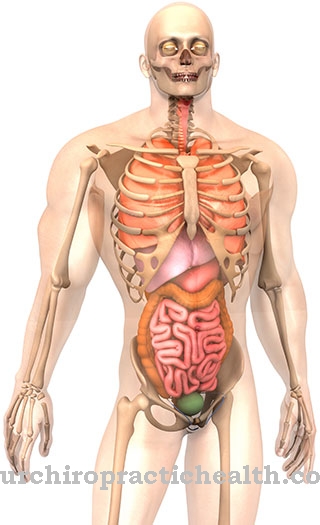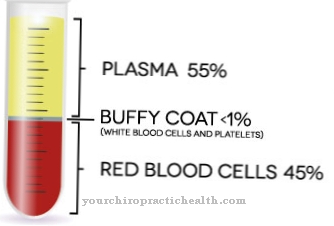The Christ-Siemens-Touraine syndrome is ectodermal dysplasia. The main symptoms of the disease are malformations of the skin appendages. The focus of the therapy is on the heat emission, as the patients often do not have fully developed sweat glands and therefore quickly overheat.
What is Christ-Siemens-Touraine Syndrome?

© solvod - stock.adobe.com
In gastrulation, three so-called germ layers form during embryonic development. This cotyledon formation occurs through cell migration in early pregnancy and is equivalent to an initial tissue differentiation. Before the cotyledon is formed, the embryonic cells are omnipotent. In the cotyledons there are only multipotent cells.
This means that the tissue of the cotyledons can only develop into certain body tissues. One of the three cotyledons is the ectoderm. In addition to the skin, the intestinal lining, the nervous system and the adrenal medulla, the ectoderm also develops sensory organs as well as teeth and tooth enamel.
Various developmental disorders and genetic defects can lead to errors in ectodermal tissue development. Such defects result in ectodermal dysplasias, for example the Christ-Siemens-Touraine syndrome. This disease corresponds to a so-called Systemic dyplasiabecause it affects different body systems.
The disease is also called anhidrotic ectodermal dysplasia denotes and corresponds to the most common dysplasia of the ectoderm. Unlike many other malformations based on ectodermal tissue, Christ-Siemens-Touraine syndrome is a genetic defect with a worldwide prevalence of around 1:10 000.
causes
The Christ-Siemens-Touraine syndrome is a malformation syndrome with a genetic basis. This means that the individual disorders of the ectodermal tissue development in this case are due to internal factors and not primarily related to external factors such as environmental toxins. The complex of symptoms is evidently inherited as an X recessive chromosomal.
The basis of the disease is a mutation of different genes that are passed on on the X chromosome. These are the genes XLHED, EDA and ED1 with mapping in the gene locus Xq12 to Xq13.1. Similar cases have been documented regardless of the X-linked inheritance.Both autosomal dominant and autosomal recessive transmission are now associated with the syndrome.
The mutations in the genes mentioned change the genetic material and thus result in physiologically unforeseen processes. The EDA gene codes in DNA, for example, for the protein ectodysplasin-A, which belongs to the family of tumor necrosis factor-α ligands.
In a healthy organism, this coding produces the gene product ectodysplasin-A, which controls the interaction between mesenchyme and epithelium. It therefore plays a role in the development control of the skin appendages, which are put together incorrectly in the event of defects in the gene.
Symptoms, ailments & signs
Patients with Christ-Siemens-Touraine syndrome suffer from various malformations of the ectodermal tissue. The skin, hair, nails, sweat glands, and sebum glands are most affected. The main symptoms are hypohidrosis, hypotrichosis and hypodontia, i.e. a lack of teeth, reduced sweat secretion and reduced hair formation.
In addition, the skin is dry, flaky, and often covered with eczema. The heat adjustments (thermoregulation) are due to the low sweat secretion, so that fever can occur. Protruding ears at an abnormal depth are as common symptoms as underdeveloped eyelashes and eyebrows, colorless hair, abnormal skin color, bulging lips or saddle noses.
In individual cases there are also frontal cusps. The more rare accompanying symptoms include additional eye diseases such as cataract or glaucoma. In still other cases, tissue degradation on the optic nerve can be observed (optic atrophy).
In addition, a regression of the retina (retinal degeneration) is conceivable as an eye symptom. In some cases, deafness has been reported in addition to the symptoms described. Short stature can also occur as part of the syndrome.
Diagnosis & course
The diagnosis of Christ-Siemens-Touraine syndrome is made on the basis of the clinical picture. The combination of reduced sweat secretion and abnormalities in hair and teeth results in a relatively typical picture. The doctor does not always make the diagnosis immediately after the birth.
In many cases, however, at the latest in early toddlerhood, the lack of or reduced application of the sweat glands becomes noticeable. A molecular genetic test can be used to confirm the diagnosis. If the test reveals mutations in the corresponding genes, the diagnosis is considered proven.
The prognosis for patients with Christ-Siemens-Touraine syndrome depends on the severity of the symptoms in the individual case. Fatal cases are known. These cases are usually associated with a high fever as a result of the thermoregulatory disorders.
When should you go to the doctor?
In most cases, Christ-Siemens-Touraine syndrome is diagnosed immediately after birth, so that an additional diagnosis is usually no longer necessary. A doctor must be consulted with this disease if the person concerned does not sweat and thus cannot properly release excessive heat into the environment. The skin and nails are also affected by the syndrome, they become flaky and dry.
In addition, the patients often suffer from reduced hair formation, so that a medical examination is advisable even with this complaint. Eye diseases can also indicate Christ-Siemens-Touraine syndrome and should be examined. The syndrome can also lead to short stature or deafness, and those affected should also consult a doctor if these symptoms occur.
The condition can be diagnosed by a pediatrician or a general practitioner. Since there is no direct treatment, those affected are dependent on special cooling options. Certain malformations can be treated by the respective specialist.
Doctors & therapists in your area
Treatment & Therapy
So far, the Christ-Siemens-Touraine syndrome is incurable. A causal therapy does not yet exist. In the case of genetic diseases, any causal therapy would have to start with the genes themselves. This is not yet possible. Gene therapy approaches have made progress over the past decades and have become a focus of medical research.
However, the approaches have not reached the clinical phase. Therefore, so far, patients with Christ-Siemens-Touraine syndrome have only received symptomatic treatment, which is combined with supportive treatment steps such as self-help groups. The focus of the therapy is the regulation of body temperature.
In this way, life-threatening conditions can be prevented. Evaporation processes are in use: in order to imitate sweating and to achieve a heat emission, the skin of the person affected is, for example, moistened. Conduction is also used by bringing the patient into contact with cool objects.
The heat dissipation to the moving ambient air can mainly take place through drafts, fans or air conditioning systems. The eating and drinking behavior of patients can also be geared towards heat regulation. To cool off, those affected drink as much cold water as possible during the day and night.
In principle, an interdisciplinary team of doctors takes over the treatment. Dentures to improve the dental situation, for example, contribute immensely to the quality of life of patients.
Outlook & forecast
The Christ-Siemens-Touraine syndrome does not heal itself. For this reason, those affected are always dependent on medical treatment. However, most of the symptoms of the syndrome can be limited relatively well so that patients can lead an ordinary life.
The skin complaints make it difficult to dissipate heat, so that those affected often suffer from fever. The patient's aesthetics are also negatively affected by the malformations of the hair and the unusual coloring of the skin.
This often leads to psychological complaints. The Christ-Siemens-Touraine syndrome can also have a negative effect on vision, with some patients also suffering from deafness or short stature. These complaints cannot be treated, so those affected have to struggle with limitations throughout their lives.
As a rule, the disturbed heat emission can be controlled relatively well through eating behavior and drinking behavior. The environment can also be adjusted so that there is no overheating or other complaints. Although the symptoms cannot be completely limited, the life expectancy of the patient is generally not negatively affected by Christ-Siemens-Touraine syndrome.
prevention
So far, the Christ-Siemens-Touraine syndrome can only be prevented through genetic counseling in family planning. Much more important than prevention can be the early detection of the disease, for example with fine ultrasound.
Aftercare
In the case of Christ-Siemens-Touraine syndrome, in most cases the patient has no or very few direct follow-up measures available. With this disease, the person concerned is primarily dependent on a quick and above all on an early diagnosis and treatment, so that further complications can be prevented. Since Christ-Siemens-Touraine syndrome is a congenital disease, it cannot be completely cured.
If those affected want to have children, genetic counseling should be given to prevent this disease from recurring. Self-healing cannot occur. Those affected have to properly regulate the release of heat themselves in this disease. This allows the skin to be moistened if it gets too hot for the heat to be dissipated.
Also strenuous or physical activities should be avoided in order not to strain the body unnecessarily. Drinking cold water can also alleviate the symptoms of Christ-Siemens-Touraine syndrome. It is not uncommon for contact with other sufferers of the syndrome to have a positive effect on the course of the disease, as information is often exchanged. Life expectancy is usually not reduced by this disease.
You can do that yourself
Unfortunately, it is not possible to treat the Christ-Siemens-Touraine syndrome itself, which leads to the cure. It is based on a mutation in the genome, so a cure would only be possible on a genetic level.
The only thing left for the affected patients to do is to treat the symptoms as part of their own therapy. In this respect, the main focus is on influencing body temperature. To counteract the overheating of the body caused by the syndrome, various measures can be taken.
This includes above all moisturizing the skin, which simulates the sweating process, which is usually severely impaired by the disease. Cooling objects pressed against the skin can also help prevent overheating. The same applies to all cooling options, be it through air conditioning or simply through drafts.
This not only improves the patient's own body feeling, but also prevents further possible body reactions through the dissipation of heat. According to the need to cool down, patients are best served cold drinks and also pay attention to the body's heat balance when eating.
The syndrome is also occasionally associated with reduced hair growth on the body; medication can help on this subject.

.jpg)
.jpg)


.jpg)







.jpg)

.jpg)
.jpg)











.jpg)